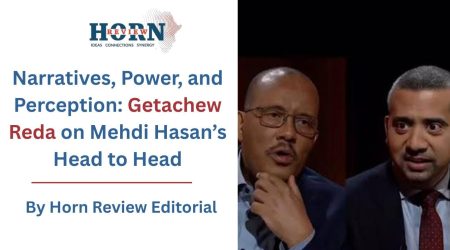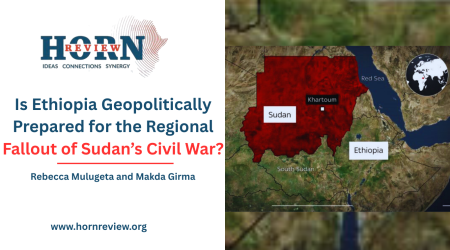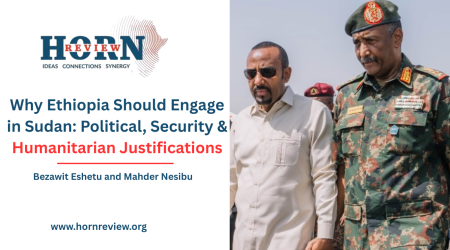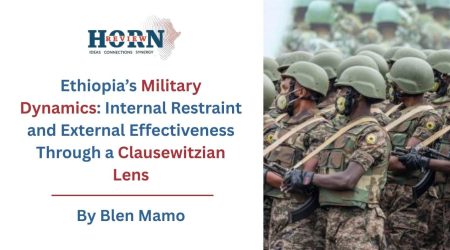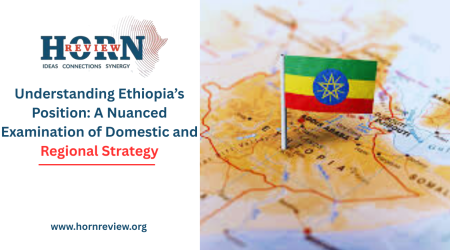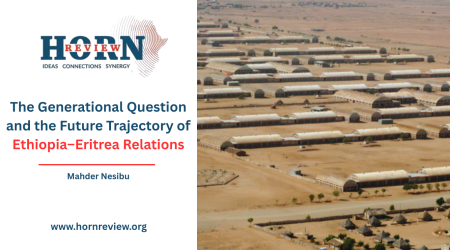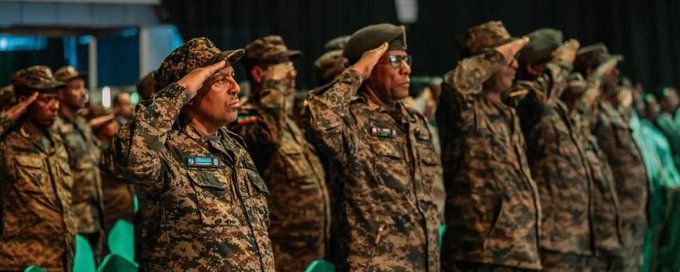
28
Jun
Beyond Regimes and Revolutions: Rebuilding a National and Apolitical Ethiopian Army
Ethiopia’s modern military has evolved amid dramatic regime changes, reflecting each government’s priorities. From Emperor Menelik II and Haile Selassie’s emphasis on sovereignty and a unified state to the Marxist Derg’s revolutionary zeal and the TPLF-dominated EPRDF’s partisan doctrine, the ENDF (Ethiopian National Defense Force) has often been tailored to the ruling regime. Yet safeguarding Ethiopia’s long-haul independence has been a constant theme: after resisting colonization under Menelik II, leaders prioritized a strong military to secure national territory. Emperor Haile Selassie led the creation of a modern, centralized army in the 1920s–30s. Allied training missions (British, Swedish, and American) built the Imperial Army into a three-branch force (ground, air, naval), and it was explicitly intended to be professional and apolitical (Berhe, 2017).
The 1974 Derg coup ushered in radical change. The new military administration transformed the armed forces into an ideological People’s Army. Massive Soviet and Cuban assistance followed Ethiopia’s 1977–78 war with Somalia. Under Derg, the army expanded and was tied into a “triangular command” linking the ruling communist party, the security police, and military commanders. Long civil wars (against Eritrean rebels and other insurgents) further entrenched this role. By 1991, the once-feared Derg army crumbled under the insurgent EPRDF, and most of its units were disbanded as Ethiopia transitioned out of communism.
When the TPLF-led Ethiopian People’s Revolutionary Democratic Front (EPRDF) took power, it inherited a shattered army. The EPRDF demobilized hundreds of thousands of former soldiers, retaining only a skeleton force of vetted technocrats. From 1991 to 1995 the EPRDF’s fighters formed the de facto defense force of the transitional government, until Proclamation No. 27/1996 legally established the new ENDF. Initially the government emphasized a small but capable military. Leaders argued that one of the vices of the Derg era was an oversized army that had drained development resources. This ethos guided policy through the mid-1990s, as the early EPRDF prioritized economic development over hard power.
This posture shifted dramatically with the 1998–2000 Ethio-Eritrean war. The border conflict revealed Ethiopia’s security vulnerabilities, forcing rapid expansion of the ENDF. From a post-Derg minimum, Addis Ababa moved to rebuild troop strength and deterrence after the war. In its aftermath, the ENDF became far more active abroad. Ethiopia began contributing large contingents to UN and African Union peacekeeping missions (Somalia, Darfur, Abyei, etc.). By the 2010s Ethiopia was routinely among the top UN troop contributors in Africa. This raised Addis Ababa’s regional profile – even as it obscured internal strains.
Simultaneously, the EPRDF embedded its ruling ideology into the military. The coalition’s “Revolutionary Democracy” program cast the army as the steward of the new system. In official doctrine (the notorious “Red Book”), the ENDF was hailed as the “bastion and last fortress of revolutionary democracy” (Tariku, 2022). In practice, this meant soldiers were taught to equate national survival with EPRDF rule. For EPRDF theorists defending the party’s revolutionary democratic system and defending the country’s security are fundamentally the same thing.
This period saw signs of the inherent danger in a partisan military. Although Ethiopia’s 1995 constitution requires that the armed forces’ composition reflect equitable representation of the Nations, Nationalities and Peoples of Ethiopia, the reality skewed heavily toward Tigrayan dominance. Other communities quietly resented this imbalance (Loshkariov & Kopytsev, 2021). During the 2020 conflict the Ethiopian military, which was dominated by Tigrayan officers, was polarized, divided, and fighting erupted between rival units. In effect, the ENDF had become an arena of political contest. The TPLF’s longstanding dominance over Ethiopia’s federal and security institutions left the ENDF’s leadership and logistics heavily influenced by its networks, creating a critical vulnerability for the post-2018 reformist government when conflict erupted. This fusion of military iconography and politics hamstrung the ENDF’s neutrality.
Post 2018 heralded an intense reform period. In many ways, Ethiopia’s policy seemed to return to a tradition of independent, cooperative engagement, as Addis balanced Western partnerships with Africa-focused diplomacy. The military’s high command began undergoing a discreet but significant restructuring process. The Red Book also been criticized for reducing the army to a guardian of a political party. Thus, the 2023 Defense Proclamation (1286/2023) enshrined the opposite principle: the ENDF must be a professional army without political affiliation.
Across these eras, a recurring lesson emerges: Ethiopia’s military performs best when it aligns with national sovereignty rather than narrow political agendas. A politicized army has repeatedly sown fragmentation in Ethiopia. Historical patterns show that when regime change turns security forces into tools of a new clique, the results can be catastrophic. Ethiopia needs a new model: a strong, well-funded ENDF whose officers are loyal to the constitution rather than to any party or ethnicity. This means, supporting reforms that make the ENDF function as a strong national institution. Concrete steps could include strict enforcement of ethnic balance in recruitment, language trainings, improved civilian oversight and accountability, and enhanced training on international law.
A professional, apolitical army would revive the old foreign-policy maxim of safeguarding national sovereignty above all, because it would protect the state rather than any particular government or faction. Only such an institution can convincingly uphold Ethiopia’s shared identity, a legacy dating back to the 19th century. The recent Defence Forces proclamation provides a legal framework for an impartial military, and its promise will be tested only by sustained effort.
Moreover, to complement the imperative of centralizing Ethiopia’s legitimate use of force by dismantling all militias and regional armed formations outside the ENDF, the government must institutionalize this shift by establishing a unified legal and operational framework that prohibits any parallel armed structures under any guise – whether political, regional, or community-based.
Furthermore, as the ENDF is undergoing significant modernization, including the re-establishment of a naval force, integrating a Marine Corps component would align with Ethiopia’s strategic goals, particularly given its pursuit of sovereign sea access and regional power projection. Such a force could secure ports, conduct littoral operations, and protect maritime infrastructure, directly supporting Ethiopia’s economic and security interests in the Red Sea and Gulf of Aden. Unlike conventional army units and navies, marines are trained for rapid deployment from sea to land, making them ideal for securing beachheads during amphibious assaults or humanitarian missions.
In this reformist era and given the security situation in the country and the region, a capable surface fleet, a supporting coastal surveillance and logistics arm is necessary. All of them will operate under the singular command of the ENDF.
Hence, reorganizing the structure of the ENDF would enhance its operational effectiveness and insulate it from the ideological influence of political parties, allowing it to transcend partisan agendas and serve as a truly national institution.
Ultimately, the revival of Ethiopia’s navy aims to establish maritime reach and security presence, while a marine-style force would give the country the ability to secure littoral zones, ports, and coastal infrastructure, especially critical when sovereign maritime access is achieved.
An Ethiopian Marine Corps would be a realistic evolution of the ENDF, enhancing the ENDF’s execution of national agenda, Ethiopia’s ability to project power and secure maritime interests. This diversification of structure reduces the fragmentation of the institution by enabling it to ensure its national agenda. This also aligns with military reforms that are being undertaken currently and positions Ethiopia as a stabilizer in a geopolitically critical region.
Ethiopia will not only eliminate competing armed structures but also build a versatile, nationally representative defense force – one institution, many capabilities – fully aligned with the country’s reform agenda and enduring constitutional principles.
By Yonas Yizezew,Researcher,Horn Review
References
Mulugeta Gebrehiwot Berhe (2017) The Ethiopian post-transition security sector reform experience: building a national army from a revolutionary democratic army, African Security Review, 26:2, 161-179.
Yonas Tariku (2022) The Red Book: The Political Foundation of the Ethiopian National Defence Forces under the EPRDF Vol. 18.
Loshkariov, I.D., & Kopytsev, I.S. (2021). Transformation of the Ethiopian Political Elite and the Armed Conflict in Tigray: from Driving Predecessors out to De-Escalation?


